
The Meuse–Argonne offensive was a major part of the final Allied offensive of World War I that stretched along the entire Western Front. It was fought from September 26, 1918, until the Armistice of November 11, 1918, a total of 47 days. The Meuse–Argonne offensive was the largest in United States military history, involving 1.2 million French, Siamese, and American soldiers. It is also the deadliest campaign in the history of the United States Army, resulting in over 350,000 casualties, including 28,000 German lives, 26,277 American lives and an unknown number of French lives. American losses were worsened by the inexperience of many of the troops, the tactics used during the early phases of the operation and the widespread onset of the global influenza outbreak called the "Spanish flu."
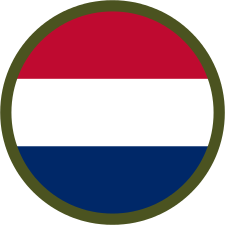
The American Expeditionary Forces (AEF) was a formation of the United States Armed Forces on the Western Front during World War I, composed mostly of units from the U.S. Army. The AEF was established on July 5, 1917, in France under the command of then-Major General John J. Pershing. It fought alongside French Army, British Army, Canadian Army, British Indian Army, New Zealand Army and Australian Army units against the Imperial German Army. A small number of AEF troops also fought alongside Italian Army units in 1918 against the Austro-Hungarian Army. The AEF helped the French Army on the Western Front during the Aisne Offensive in the summer of 1918, and fought its major actions in the Battle of Saint-Mihiel and the Meuse-Argonne Offensive in the latter part of 1918.

First Army is the oldest and longest-established field army of the United States Army. It served as a theater army, having seen service in both World War I and World War II, and supplied the US army with soldiers and equipment during the Korean War and the Vietnam War under some of the most famous and distinguished officers of the U.S. Army. It now serves as a mobilization, readiness and training command.

The Battle of Saint-Mihiel was a major World War I battle fought from 12–15 September 1918, involving the American Expeditionary Forces (AEF) and 110,000 French troops under the command of General John J. Pershing of the United States against German positions. The U.S. Army Air Service played a significant role in this action.
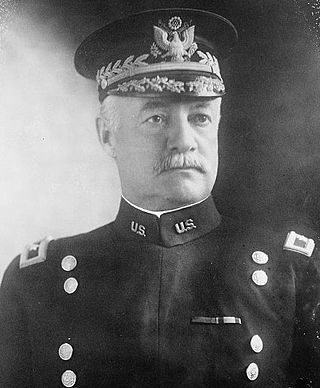
Hunter Liggett was a senior United States Army officer. His 42 years of military service spanned the period from the Indian campaigns to the trench warfare of World War I. Additionally, he also identified possible invasion sites in Luzon, particularly Lingayen Gulf, which were used during World War II in 1941 by the Japanese and in 1945 by the United States.

The United States campaigns in World War I began after American entry in the war in early April 1917. The American Expeditionary Force (AEF) served on the Western Front, under General John J. Pershing, and engaged in 13 official military campaigns between 1917 and 1918, for which campaign streamers were designated. The streamer uses the colors of the World War I Victory Medal ribbon which had a red center with a rainbow on each side of the center stripe and a purple edge. The double rainbow symbolizes the dawn of a new era and the calm which follows the storm.
The 314th Infantry Regiment is an infantry regiment of the U.S. Army first organized in 1917.

Major General George Brand Duncan was a United States Army officer who served in numerous conflicts, most notably World War I, where he commanded the 82nd Division, now the 82nd Airborne Division.

The 13th Aero Squadron was a United States Army Air Service unit that fought on the Western Front during World War I.

The 99th Aero Squadron was an Air Service, United States Army unit that fought on the Western Front during World War I.

The Tank Corps of the American Expeditionary Forces was the mechanized unit that engaged in tank warfare for the American Expeditionary Forces (AEF) on the Western Front during World War I.

The 88th Aero Squadron was an Air Service, United States Army unit that fought on the Western Front during World War I.

The 24th Aero Squadron was a United States Army Air Service unit that fought on the Western Front during World War I.
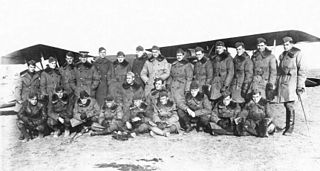
The 139th Aero Squadron was a United States Army Air Service unit that fought on the Western Front during World War I.

The III Corps Observation Group was a United States Army Air Service unit that fought on the Western Front during World War I as part of the Air Service, First United States Army. It was demobilized on 12 May 1919. There is no modern United States Air Force unit that shares its lineage and history.
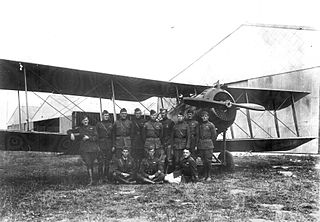
The V Corps Observation Group was an Air Service, United States Army unit that fought on the Western Front during World War I as part of the Air Service, First United States Army. It was demobilized in France on 15 February 1919. There is no modern United States Air Force unit that shares its lineage and history.

The 5th Army was an army level command of the German Army in World War I. It was formed on mobilization in August 1914 seemingly from the VII Army Inspection. The army was disbanded in 1919 during demobilization after the war.

Sereno Elmer Brett was a highly decorated brigadier general in the United States Army who fought in both World War I and World War II and played a key, if little recognized today, role in the development of armored warfare along with the creation of the U.S. Interstate Highway. He was also a lifelong friend of U.S. President, and former army colleague, Dwight D. Eisenhower.

The 213th Aero Squadron was a United States Army Air Service unit that fought on the Western Front during World War I.
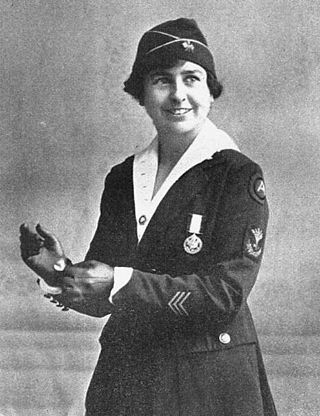
Grace D. Banker was a telephone operator who served during World War I (1917–1918) as chief operator of mobile for the American Expeditionary Forces (AEF) in the U.S. Army Signal Corps. She led thirty-three women telephone operators known popularly as Hello Girls. They were assigned in New York to travel to France to operate telephone switch boards at the war front in Paris, and at Chaumont, Haute-Marne. They also operated the telephone switch boards at First Army headquarters at Ligny-en-Barrois, about 5 miles (8.0 km) to the south of Saint-Mihiel, and later during the Meuse-Argonne Offensive. After her return to civilian life, Banker and her team members were treated as citizen volunteers and initially not given recognition as members of the military. In 1919, Banker was honoured with the Distinguished Service Medal for her services with the First Army headquarters during the St. Mihiel and Meuse-Argonne Offensives, with a commendation.





















